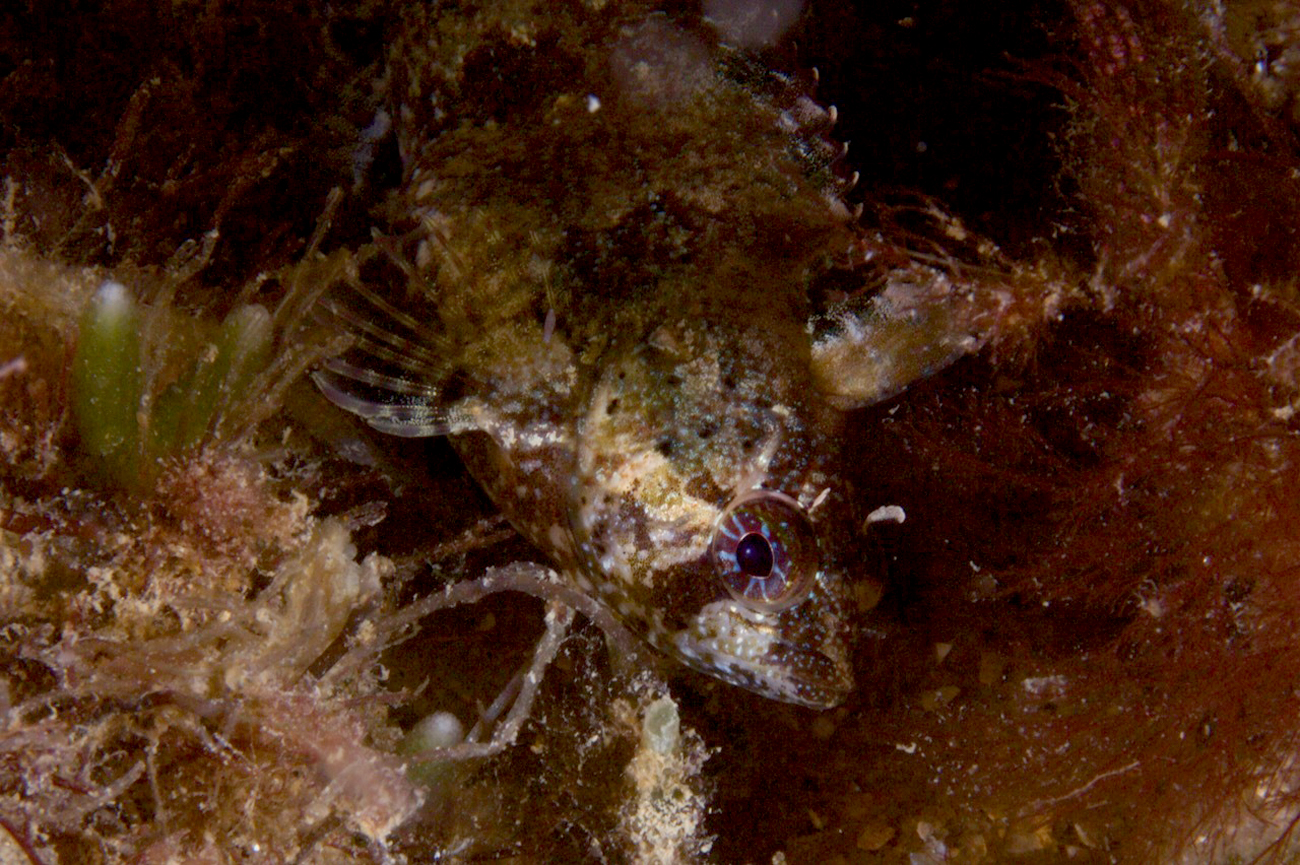- Classification
- ACTINOPTERYGII
- PERCIFORMES
- CLINIDAE
- Heteroclinus
- heptaeolus
Ogilby's Weedfish, Heteroclinus heptaeolus (Ogilby 1885)
Other Names: Common Weedfish, Seven-bar Weedfish

Ogilby's Weedfish, Heteroclinus heptaeolus, at the old Sea Baths, Brighton, Port Phillip, Victoria, October 2017. Source: Rebecca Lloyd / iNaturalist.org. License: CC By Attribution-NonCommercial
Summary:
A reddish-brown to greenish-brown weedfish, either of uniform colour or with seven to eight broad brown to broken black bars along the body and tail forming saddles along the back, a pale crescent-shaped bar on the upper pectoral-fin base, sometimes short bars bars radiating from the rear of the eye, and single silver or white bar extending from behind the eye.
The orbital tentacles are short, broad, rounded, and sometimes weakly lobed, about twice as long as wide, and the nasal tentacles entire to weakly lobed.
The second dorsal and anal fins have clear interspaces between dark blotches, the first dorsal fin is dark, and the other fins have series of dark spots forming transverse bands.
The orbital tentacles are short, broad, rounded, and sometimes weakly lobed, about twice as long as wide, and the nasal tentacles entire to weakly lobed.
The second dorsal and anal fins have clear interspaces between dark blotches, the first dorsal fin is dark, and the other fins have series of dark spots forming transverse bands.
Cite this page as:
Bray, D.J. 2024, Heteroclinus heptaeolus in Fishes of Australia, accessed 01 Jul 2025, https://fishesofaustralia.net.au/Home/species/2
Ogilby's Weedfish, Heteroclinus heptaeolus (Ogilby 1885)
More Info
|
Distribution |
Widespread in the southern half of Australia, from about Seal Rocks, New South Wales, to Breton Bay, Western Australia, including around Tasmania. Inhabits macroalgae and seagrass beds in sheltered bays at depths to 20 m. |
|
Features |
Dorsal fin III, XXVI-XXVIII, 3; Anal fin II, 18-21; Caudal fin (segmented rays) 10-12; Pectoral fin 11-13; Pelvic fin I, 3; Lateral line (arched part) 20-26 + (straight part) 22-23; Gill rakers 1-4 + 5-8 = 7-10; Circumorbital head pores 14-20, arranged uniserially. Body moderately deep (depth at anal fin origin 23-31% SL), strongly compressed; caudal peduncle very slender. Head of moderate size (22-28% SL); eyes of moderate size (5-9% SL); mouth of small to moderate size (upper jaw length 6-10% SL), reaching to below anterior edge of pupils; each orbital tentacle short, broad, rounded, sometimes weakly lobed (2-5% SL), about twice as long as wide; nasal tentacles entire to weakly lobed; gill rakers simple. Scales on body cycloid; lateral line scales extending to caudal peduncle, anterior scales overlapping, each with one median posterior pore, posterior scales not overlapping, each with median pore at either end. Two dorsal fins, first dorsal low (second spine 7-11% SL), originating over middle of preopercles; last spine of first dorsal fin connected by membrane to base of second dorsal fin, last ray connected by membrane to base of caudal fin; last two dorsal rays widely separated from preceding ray; anal fin membrane deeply incised; last anal ray connected along half its length by membrane to caudal peduncle; caudal fin rounded (15-20% SL). Pectoral fins large, rounded. Pelvic fins jugular, rays stout, not reaching to anus, inner ray about half to two thirds length of second ray. |
|
Etymology |
The specific name is from the Greek hepta (= seven) and aeolos (= variegated), possibly in reference to the seven dark spots or blotches along the back. |
|
Species Citation |
Petraites heptaeolus Ogilby 1885, Proc. Linn. Soc. N. S. W. 1 10(2): 225. Type locality: Port Jackson, New South Wales. |
|
Author |
Bray, D.J. 2024 |
|
Resources |
Ogilby's Weedfish, Heteroclinus heptaeolus (Ogilby 1885)
References
Hoese, D.F., Gomon, M.F. & Rennis, D.S. 2008. Family Clinidae. pp. 696-722 in Gomon, M.F., Bray, D.J. & Kuiter, R.H. (eds). Fishes of Australia's Southern Coast. Sydney : Reed New Holland 928 pp.
Kuiter, R.H. 1993. Coastal Fishes of South-eastern Australia. Bathurst : Crawford House Press 437 pp.
Kuiter, R.H. & Kuiter, S.L. 2018. Fish watchers guide to coastal sea-fishes of south-eastern Australia. Seaford, Victoria : Aquatic Photographics, 371 pp.
Last, P.R., Scott, E.O.G. & Talbot, F.H. 1983. Fishes of Tasmania. Hobart : Tasmanian Fisheries Development Authority 563 pp. figs.
McCulloch, A.R. 1908. Studies in Australian fishes, No. 1. Records of the Australian Museum 7(1): 36-43 pls 10-11 https://doi.org/10.3853/j.0067-1975.7.1908.949
Ogilby, J.D. 1885. Descriptions of new fishes from Port Jackson. Proceedings of the Linnean Society of New South Wales 1 10(2): 225-230 See ref at BHL
Rennis, D., Hoese, D.F. & Gomon, M.F. 1994. Family Clinidae. pp. 741-775, figs 650-684B in Gomon, M.F., Glover, C.J.M. & Kuiter, R.H. (eds). The Fishes of Australia's South Coast. Adelaide : State Printer 992 pp. 810 figs.
Williams, J.T., Holleman, W. & Clements, K.D. 2014. Heteroclinus heptaeolus. The IUCN Red List of Threatened Species 2014: e.T178897A1545028. http://dx.doi.org/10.2305/IUCN.UK.2014-3.RLTS.T178897A1545028.en. Downloaded on 17 August 2016.









